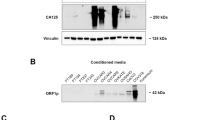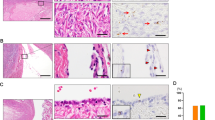Abstract
The EVI-1 gene was originally detected as an ectopic viral insertion site and encodes a nuclear zinc finger DNA-binding protein. Previous studies showed restricted EVI-1 RNA or protein expression during ontogeny; in a kidney and an endometrial carcinoma cell line; and in normal murine oocytes and kidney cells. EVI-1 expression was also detected in a subset of acute myeloid leukaemias (AMLs) and myelodysplasia. Because EVI-1 is expressed in the urogenital tract during development, we examined ovarian cancers and normal ovaries for EVI-1 RNA expression using reverse transcription polymerase chain reaction (RT-PCR) and RNAase protection. Chromosome abnormalities were examined using karyotypes and whole chromosome 3 and 3q26 fluorescence in situ hybridisation (FISH). RNA from six primary ovarian tumours, five normal ovaries and 47 tumour cell lines (25 ovarian, seven melanoma, three prostate, seven breast and one each of bladder, endometrial, lung, epidermoid and histiocytic lymphoma) was studied. Five of six primary ovarian tumours, three of five normal ovaries and 22 of 25 ovarian cell lines expressed EVI-1 RNA. A variety of other non-haematological cancers also expressed EVI-1 RNA. Immunostaining of ovarian cancer cell lines revealed nuclear EVI-1 protein. In contrast, normal ovary stained primarily within oocytes and faintly in stroma. Primary ovarian tumours showed nuclear and intense, diffuse cytoplasmic staining. Quantitation of EVI-1 RNA, performed using RNAase protection, showed ovarian carcinoma cells expressed 0 to 40 times the EVI-1 RNA in normal ovary, and 0-6 times the levels in leukaemia cell lines. Southern analyses of ovarian carcinoma cell lines showed no amplification or rearrangements involving EVI-1. In some acute leukaemias, activation of EVI-1 transcription is associated with translocations involving 3q26, the site of the EVI-1 gene. Ovarian carcinoma karyotypes showed one line with quadruplication 3(q24q27), but no other clonal structural rearrangements involving 3q26. However, whole chromsome 3 and 3q26 FISH performed on lines with high EVI-1 expression showed translocations involving chromosome 3q26. EVI-1 is overexpressed in ovarian cancer compared with normal ovaries, suggesting a role for EVI-1 in solid tumour carcinogenesis or progression. Mechanisms underlying EVI-1 overexpression remain unclear, but may include rearrangements involving chromosome 3q26.
This is a preview of subscription content, access via your institution
Access options
Subscribe to this journal
Receive 24 print issues and online access
$259.00 per year
only $10.79 per issue
Buy this article
- Purchase on Springer Link
- Instant access to full article PDF
Prices may be subject to local taxes which are calculated during checkout
Similar content being viewed by others
Author information
Authors and Affiliations
Rights and permissions
About this article
Cite this article
Brooks, D., Woodward, S., Thompson, F. et al. Expression of the zinc finger gene EVI-1 in ovarian and other cancers. Br J Cancer 74, 1518–1525 (1996). https://doi.org/10.1038/bjc.1996.583
Issue Date:
DOI: https://doi.org/10.1038/bjc.1996.583
This article is cited by
-
The urothelial gene regulatory network: understanding biology to improve bladder cancer management
Oncogene (2024)
-
High EVI1 and PARP1 expression as favourable prognostic markers in high-grade serous ovarian carcinoma
Journal of Ovarian Research (2023)
-
EVI1 expression in early-stage breast cancer patients treated with neoadjuvant chemotherapy
BMC Cancer (2022)
-
PBK, targeted by EVI1, promotes metastasis and confers cisplatin resistance through inducing autophagy in high-grade serous ovarian carcinoma
Cell Death & Disease (2019)
-
Ecotropic viral integration site 1 promotes metastasis independent of epithelial mesenchymal transition in colon cancer cells
Cell Death & Disease (2018)



